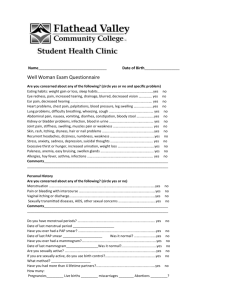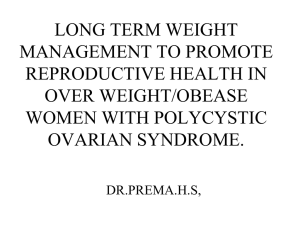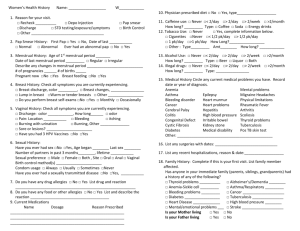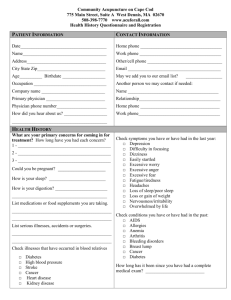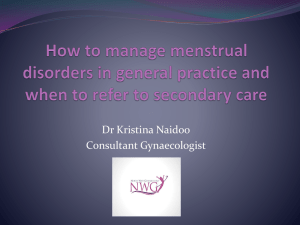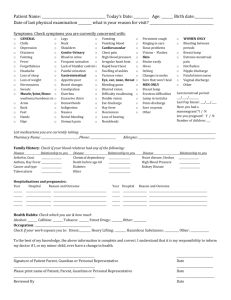Dr Asha Verma Professor SMS Medical college Jaipur
advertisement
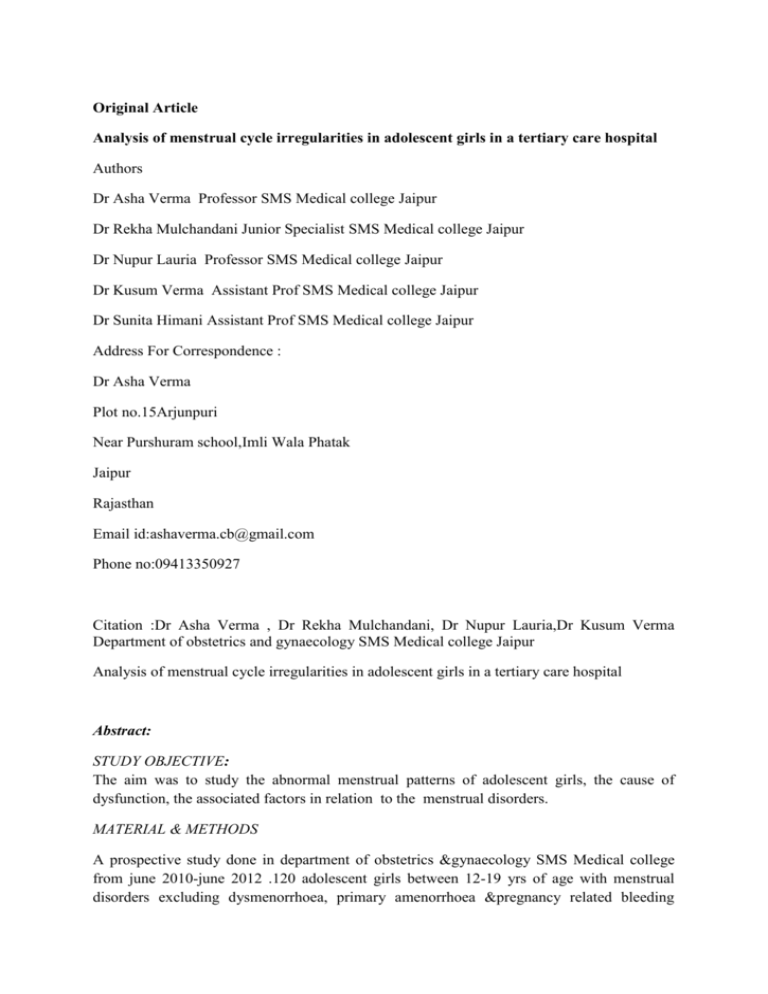
Original Article Analysis of menstrual cycle irregularities in adolescent girls in a tertiary care hospital Authors Dr Asha Verma Professor SMS Medical college Jaipur Dr Rekha Mulchandani Junior Specialist SMS Medical college Jaipur Dr Nupur Lauria Professor SMS Medical college Jaipur Dr Kusum Verma Assistant Prof SMS Medical college Jaipur Dr Sunita Himani Assistant Prof SMS Medical college Jaipur Address For Correspondence : Dr Asha Verma Plot no.15Arjunpuri Near Purshuram school,Imli Wala Phatak Jaipur Rajasthan Email id:ashaverma.cb@gmail.com Phone no:09413350927 Citation :Dr Asha Verma , Dr Rekha Mulchandani, Dr Nupur Lauria,Dr Kusum Verma Department of obstetrics and gynaecology SMS Medical college Jaipur Analysis of menstrual cycle irregularities in adolescent girls in a tertiary care hospital Abstract: STUDY OBJECTIVE: The aim was to study the abnormal menstrual patterns of adolescent girls, the cause of dysfunction, the associated factors in relation to the menstrual disorders. MATERIAL & METHODS A prospective study done in department of obstetrics &gynaecology SMS Medical college from june 2010-june 2012 .120 adolescent girls between 12-19 yrs of age with menstrual disorders excluding dysmenorrhoea, primary amenorrhoea &pregnancy related bleeding problems were included in the study. After detailed history, examination all had an ultrasound, thyroid profile & serum prolactin levels .Other investigations done if required according to clinical profile of the patients RESULTS: 50% of the girls presented at 18-19 years. 83.3% attained menarche between 12-14 years of age Menorrhagia & oligo-hypomenorrhoea were the most common dysfunction, i.e 26.7% each, abnormal investigative profile was more common in patients with oligo hypomenorrhoea,40% of patients with oligo and/or hypomenorrhoea had PCOS, 14% had hyperprolactinaemia,7% had hypothyroidism . 1/3 of these patients had normal hormonal & USG findings .Majority (72.2% ) of the patients with menorrhagia and /or metrorrhagia had normal hormonal and USG findings. CONCLUSIONS: Evaluation of bleeding problems in adolescents is justified, before considering them as normal physiological transition. Although most problems are explained by anovulation other causes must be considered & excluded Hormonal evaluation of these patients is justified & reveals unsuspected pathology Introduction World Health Organization has defined ‘adolescence’ as a period between 10-19 years. In Indian con- text, adolescents constitute over 21.4% of the total population and this age group needs spe- cial attention because this period is very cru- cial since these are the formative years in the life of an individual when major physical, psy- chological and behavioral changes take place and additional roles and responsibilities are expected from them [1, 2)In many societies puberty onset is celebration time ,it announces acquisition of fertilityhowever physiological social, cultural forces make it stressful ,difficult transition for many . In India very little attention is paid to reproductive health of adolescent girls comprising 22% females. Reasons for neglect are ignorance, indifference,reluctance of parents & girls to consult a Doctor. OBJECTIVES: This study was undertaken to evaluate abnormal menstrual patterns of adolescent girls, to investigate the cause of dysfunction, to study the associated factors in relation to the menstrual disorders. MATERIAL & METHODS The study group consists of 120 adolescent girls with menstrual disorders excluding (dysmenorrhoea, primary amenorrhoea &pregnancy related bleeding problems were included in the study. All patients underwent detailed history ,examination ,ultrasound &analysis of hormonal status (thyroid profile , serum prolactin, other investigations were done if required depending on the clinical profile of the patients) at department of obstetrics &gynaecology SMS Medical college from june 2010 to june 2012 Common menstrual problems definitions used to collect data (3,4,5,6): Regular menstrual cycle: Cycle that occurs every 28 ± 2-3 days in which the menstrual flow lasts for 3-5 days with an average flow of 50- 200 ml. Irregular menstrual cycle: any deviation from cyclic occurrence of menstrual cycle i.e. 28 ± 2-3 days. Oligomenorrhea: very light menstruations, usually 4-9 periods per year. Menorrhagia: denotes bleeding, which is ex- cessive in amount i. e .>500ml ( soaked pads > 5/day) or periods that last longer than 7 days. Metrorrhagia: breakthrough bleeding or spot- ting in-between periods. Hypomenorrhoea (scanty): denotes regularly timed bleeding but scanty (<50 ml) in amount. polymenorrhea was defined as a menstruation interval lasting less than 21 days. Statistics: Table1 Chi-square = 40.39 with 15 degrees of freedom; P = <0.001 S Interpretation: Statistically significant difference was observed between different types of menstrual disorders and age. The proportion of cases of Menorrhagia was decreasing as age increases while proportion of cases of oligo and hypomenorrhoea, increased with age. Results Common menstrual problems faced by these adolescents are given in Table 1. Out of 120 girls ,frequency and percentages of common menstrual problems like oligomenorrhea, men- orrhagia (profuse bleeding), oligo- hypomenorrhoea, metrorrhagia (break through bleeding), hypomenorrhea (scanty bleeding), polymenorrhea were 21(17.5%), 32(26.7%), 32(26.7%), 22(18.3%), 8(6.6) and 5(4.2%), respectively. Figure1 depicts the associated complaints with menstrual disorders .About 53% patients had no associated complaints. Of the remaining 23.% patients presented with infertility &hisuitism, obesity, acne, pain abdomen, weight loss& hoarseness in14%,13%,8%,2.5%,1.7%&0.8%respectively Fig 2 depicts the ultrasound findingsin adolescent girls ,with normal study, abnormal ovarian findings,abnormal uterus findings in 50%,35% and 15% patients respectively Oligomenorhoea &/or hypomenorrhoea(58,48.3%): In this group associated complaints and the diagnosis were studied in detail as follows Table 2 gives that of the oligo-hypomenorrhoea group,15 (25.9%)patients had obesity with/without hirsuitism & were diagnosed as PCOS, Hyperprolactnemia , Hypothyroidism, and Cushings syndrome in 86.7%,20%,20% and 6.7% respectively Table 3 gives that of the oligo-hypomenorrhoea group,21 (36.2%)patients had Infertility .Of these patients 42.9% patients had normal investigations,however 23.8% diagnosed as PCOS,14.3% had Hyperprolactinemia,9.5% had Endometriosis, ovarian cyst in 19%,hydrosalpinx in 13.3 % ,fibroid in 4.8% Table 4 gives that of the oligo-hypomenorrhoea group 7 (12.1%)patients had only hirsuitism .Of these patients 28.6% patients had normal investigations,however 42.8% diagnosed as PCOS,14.3% had Hyperprolactinemia,9.5% had Endometriosis,multiple follicles in ovary in 14.3%,hypothyroidism in 14.3%,raised testosterone in 28.6%. Table 5 shows oligo-hypomenorrhoea group with no associated complaints. Of these 60% had normal investigations,20% had PCOS,13.3 had hyperprolactinemia & 13.3% had ovarian cyst Table 6 shows diagnosis of girls with menorrhagia / metrorrhagia. Of these 90.7%had anaemia, 20%had Hyperprolactinemia,3.7% had jaundice,6.7% had ITP,1.9% had PCOS & ovarian cyst in 13.3% DISCUSSION The data shows 50% of the girls presented at 18-19 years, 83.3% had attained menarche between 12-14 years of age. In this study Menorrhagia & oligo-hypomenorrhoea were the most common dysfunction, i.e 26.7% each. Mohite RV1etal(7) studied Out of 230 girls with attainment of menstrua- tion, frequency and percentages of common menstrual problems like oligomenorrhea, men- orrhagia , metrorrhagia, hypomenorrhea , dysmenorrhea and premenstrual syndrome were 37(16.08%), 41(17.82%), 63(27.39%), 137(59.56%), 113(49.13%) and 107(46.52%) respectively However abnormal investigative profile was more common in patients with oligo hypomenorrhoea. There was an overlap of two or more pathological conditions in few patients . Of those with oligo and or hypomenorrhoea 40% of patients had PCOS. Arefi S 2001 (8)research shows that PCO was seen to be more common in adolescent girls with menstrual irregularity (42.5% ) with a tendency to be more frequent in oligomenorrhea– amenorrhea group than in polymenorrhea (51.6% vs 25% ) In our study group of oligohypomenorrhoea 14% had hyperprolactinaemia, 7% had hypothyroidism. Krassas GE (9)Studied of the 171 hypothyroid patients, 131 (76.6%) had regular cycles and 40 (23.4%) irregular periods. Oligomenorrhoea and menorrhagia were the most common features in the latter group. Also one third had normal hormonal & USG findings . While majority (72.2% ) of the patients with menorrhagia and /or metrorrhagia had normal hormonal and USG findings..The present study shows that 1.9%(1/54) of pubertymenorrhagia was due to polycystic ovarian disease. Rao(10) found 2.8 % of the cause of puberty menorrhagia were due to polycystic ovarian disease.More than half of the girls were anaemic with 11.7% requiring blood transfusion . Bleeding disorder was detected in 2% Immune thrombocytopenia purpura (ITP) may also present with menorrhagia in the adolescent (associated with bruising, petechiae and mucosal bleeding) requir- ing specialist haematological assessment (Bevan et al, 2001(11). Claessens et al., 1981(12) studied 9 year audit of paediatric cases in the USA from 1971 to 1980 revealed that a primary coagulation disorder was found in almost 20% of 59 patients admitted to a children's hospital for acute menorrhagia, where genital tract pathology had been excluded. One- quarter of those with severe menorrhagia (haemoglobin <10 g/100 ml), one-third of those requiring transfusion, and one-half of those presenting at menarche had such an underlying disorder . Bravender T, Emans SJ(13) studied in adolescents, the prevalence of a primary coagulation disorder requiring hospitalization for abnormal uterine bleeding ranges from 3% to 20% CONCLUSIONS: We found PCOS to be frequent endocrine mechanisms of menstrual disorders in teenagers Evaluation of bleeding problems observed in adolescents is justified, before considering them as normal physiological transition . Although most problems are explained by anovulation other causes must be considered & excluded in a logical ,evidence based &cost effective manner. Hormonal evaluation of these patients is justified & reveals unsuspected pathology References 1. Hanson M, Gluckman P. Evolution: devel- opment and timing of puberty. Trends in Endocrinology & Metabolism 2006; 17 (1): 7-12. 2. Kishore J. National Health Programs of India.Century publications, New Delhi; 5th ed. p53-54. 3. Dutta DC. Textbook of Obstetrics, 20th ed .Central Book House publisher: 2010: p69. 4. Howkins and Bourne. Shaw’s text book of Gynecology,12th ed. Elsevier India Private Ltd:2004:p 226. 5.Glueck CJ, Morrison JA, Daniels S, Wang P, Stroop D. Sex hormone-binding globu- lin, oligomenorrhea, polycystic ovary syn- drome, and childhood insulin at age 14 years predict metabolic syndrome and class III obesity at age 24 years. J Pediatr 2011; 159(2):308-13. 6.Mackay HT. Abnormal menstrual bleeding. Current medical diagnosis and treatment. McGraw Hill 2005; 704. 7. JKIMSU, Vol. 2, No. 1, Jan-June 2013Common Menstrual Problems among Slum Adolescent Girls of Western Maharashtra, India Mohite RV1*, Mohite VR2, Kumbhar SM1, Ganganahalli P1 1Dept. of Community Medicine 8.Arefi S. PCO Prevalance in adolescents with menstrual irregularity. J Reprod Infertil. 2001;2(1):57-62 9. Krassas GE, Pontikides N, Kaltsas T, Papadopoulou P, Paunkovic J, Paunkovic N, Duntas LH. Disturbances of menstruation in hypothyroidism Clinical Endocrinology Volume 50, Issue 5, pages 655–659, May 1999 10. Rao S, Pawar V, Badhwar VR, Fonseca MN.Medical intervention in puberty menorrhagia.BombayHospitalJournal2004;46(2) 11.Bevan, J.A., Maloney, K.W., Hillery, C.A., Gill, J.C., Montgomery, R.R. and Scott, J.P. (2001) Bleeding disorders: a common cause of menorrhagia in adolescents. J. Pediatr., 138, 856±861. 12.Claessens, E.A. and Cowell, C.A. (1981) Acute adolescent menorrhagia. Am. J. Obstet. Gynecol., 139, 277±280. 13. Bravender T, Emans SJ. Menstrual disorders: dysfunctional uterine bleeding. Pediatr Clin North Am 1999; 46(3): 545-53. Tables and figures Table 1 Age wise Distribution of cases according to type of menstrual disorder Age Group Metrorrha gia Oligomeno rrhoea No % Oligohypomenor rhoea No % No % No % 12-13 yrs 7(53.8) 1(7.69) 4(30.77) 1(7.69) 0 0 13 14-15 yrs 11(44) 3(12) 6(24) 3(12) 0 2(8) 25 5(21.74) 4(17.39) 1(4.35) 5(21.74) 2(8.70) 23 16-17 yrs Menorrha gia 6(26.08) Hypomenorr hoea No % Polymenorrh oea Total No % 18-19 yrs 8(13.56) 23(38.98) 8(13.56) 16(27.12) 3(5.08) 1(1.69) 59 Total 32(26.7) 32(26.7) 22(18.3) 21(17.5) 8(6.6) 5(4.2) 120 Fig1 Distribution of cases according to the associated complaints associated complaints% % 52.5 23.2 14.2 13.3 8.3 2.5 1.7 0.8 Fig2 Distribution of cases according to USG findings USG findings % 50% normal 15% Abnormal ovarian 35% Table 2 Associated complaints Obesity with/ without hirsuitism 15(25.9%) investigations no % normal Increased LH/FSH Hyperprolactinemia Increased TSH Abnormal GTT Increased cortisol Increased insulin USG PCO MFO Thin endometrium 0 4 3 3 3 3 1 0 26.7 20 20 20 20 6.7 13 2 2 86.7 13.3 13.3 Diagnosis no % PCO Hyperprolactinemia Hypothyroidism Cushings syndrome 13 3 3 1 86.7 20 20 6.7 Table 3 Associated complaints Infertility 21(36.2%) Investigations no % Diagnosis no % normal 9 42.9 normal 9 42.9 Increased prolactin USG PCO Ovarian cyst MFO fibroid 3 14.3 Hyperprolactinemia 3 14.3 5 4 1 1 Endometriosis 23.8 PCOS 19 Ovarian cyst 4.8 hydrosalpinx 4.8 fibroid 9.5 23.8 19 13.3 4.8 2 5 4 3 1 Table 4 Associated complaints Hirsuitism 7 (12.1%) investigations no % Diagnosis no % normal USG PCO MFO Increased TSH Increased Testosterone 2 28.6 3 1 1 2 42.8 14.3 14.3 28.6 normal Endometriosis PCOS MFO Hypothyroidism Increased Testosterone 2 2 3 1 1 2 28.6 9.5 42.8 14.3 14.3 28.6 Table 5 Associated investigations complaints normal None 15(25.9%) Increased LH/FSH Increased prolactin Abnormal GTT Increased cortisol Increased insulin USG PCO MFO Ovarian cyst no % Diagnosis no 9 3 2 1 1 1 60 20 13.3 6.7 6.7 6.7 normal 9 PCO 3 Hyperprolactinemia 2 60 20 13.3 2 2 2 13.3 13.3 13.3 Ovarian cyst 13.3 2 % Table 6 Investigations profile of patients with Menorrhagia and /Metrorrhagia group(54,45%) Investigations Haemoglobin Increased prolactin Increased bilirubin Low platelets USG Thickened endometrium PCO MFO Ovarian cyst no 49 2 2 1 % 90.7 3.7 3.7 6.7 5 9.3 1 1 3 1.9 1.9 5.6 Diagnosis anaemia Hyperprolactinemia Jaundice ITP no 49 3 2 1 % 90.7 20 3.7 6.7 PCO 1 1.9 Ovarian cyst 3 13.3
